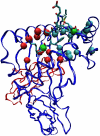Immunoinformatics comes of age
- PMID: 16846250
- PMCID: PMC1484584
- DOI: 10.1371/journal.pcbi.0020071
Immunoinformatics comes of age
Abstract
With the burgeoning immunological data in the scientific literature, scientists must increasingly rely on Internet resources to inform and enhance their work. Here we provide a brief overview of the adaptive immune response and summaries of immunoinformatics resources, emphasizing those with Web interfaces. These resources include searchable databases of epitopes and immune-related molecules, and analysis tools for T cell and B cell epitope prediction, vaccine design, and protein structure comparisons. There is an agreeable synergy between the growing collections in immune-related databases and the growing sophistication of analysis software; the databases provide the foundation for developing predictive computational tools, which in turn enable more rapid identification of immune responses to populate the databases. Collectively, these resources contribute to improved understanding of immune responses and escape, and evolution of pathogens under immune pressure. The public health implications are vast, including designing vaccines, understanding autoimmune diseases, and defining the correlates of immune protection.
Conflict of interest statement
Figures

Similar articles
-
Immunoinformatics Approach for the Identification and Characterization of T Cell and B Cell Epitopes towards the Peptide-Based Vaccine against SARS-CoV-2.Arch Med Res. 2021 May;52(4):362-370. doi: 10.1016/j.arcmed.2021.01.004. Epub 2021 Jan 29. Arch Med Res. 2021. PMID: 33546870 Free PMC article. Review.
-
Immunoinformatics and Epitope Prediction.Methods Mol Biol. 2020;2131:155-171. doi: 10.1007/978-1-0716-0389-5_6. Methods Mol Biol. 2020. PMID: 32162252 Review.
-
Databases for B-cell epitopes.Methods Mol Biol. 2014;1184:135-48. doi: 10.1007/978-1-4939-1115-8_7. Methods Mol Biol. 2014. PMID: 25048122
-
Databases for T-cell epitopes.Methods Mol Biol. 2014;1184:123-34. doi: 10.1007/978-1-4939-1115-8_6. Methods Mol Biol. 2014. PMID: 25048121
-
An introduction to epitope prediction methods and software.Rev Med Virol. 2009 Mar;19(2):77-96. doi: 10.1002/rmv.602. Rev Med Virol. 2009. PMID: 19101924 Review.
Cited by
-
A novel tuberculosis DNA vaccine in an HIV-1 p24 protein backbone confers protection against Mycobacterium tuberculosis and simultaneously elicits robust humoral and cellular responses to HIV-1.Clin Vaccine Immunol. 2012 May;19(5):723-30. doi: 10.1128/CVI.05700-11. Epub 2012 Mar 29. Clin Vaccine Immunol. 2012. PMID: 22461526 Free PMC article.
-
In silico analysis of chimeric espA, eae and tir fragments of Escherichia coli O157:H7 for oral immunogenic applications.Theor Biol Med Model. 2009 Dec 8;6:28. doi: 10.1186/1742-4682-6-28. Theor Biol Med Model. 2009. PMID: 19995413 Free PMC article.
-
Diversity and evolution of computationally predicted T cell epitopes against human respiratory syncytial virus.PLoS Comput Biol. 2023 Jan 10;19(1):e1010360. doi: 10.1371/journal.pcbi.1010360. eCollection 2023 Jan. PLoS Comput Biol. 2023. PMID: 36626370 Free PMC article.
-
Early immunologic correlates of HIV protection can be identified from computational analysis of complex multivariate T-cell flow cytometry assays.Bioinformatics. 2012 Apr 1;28(7):1009-16. doi: 10.1093/bioinformatics/bts082. Epub 2012 Feb 29. Bioinformatics. 2012. PMID: 22383736 Free PMC article.
-
In Silico Methods in Antibody Design.Antibodies (Basel). 2018 Jun 29;7(3):22. doi: 10.3390/antib7030022. Antibodies (Basel). 2018. PMID: 31544874 Free PMC article. Review.
References
-
- Saphire EO, Parren PW, Pantophlet R, Zwick MB, Morris GM, et al. Crystal structure of a neutralizing human IGG against HIV-1: A template for vaccine design. Science. 2001;293:1155–1159. - PubMed
-
- Hanada K, Yewdell JW, Yang JC. Immune recognition of a human renal cancer antigen through post-translational protein splicing. Nature. 2004;427:252–256. - PubMed
-
- Janeway CA, Travers P, Walport M, Shlomchik M. Immunobiology. New York: Garland Science Publishing; 2005. 600. p.
-
- Rudolph MG, Stanfield RL, Wilson IA. How TCRs bind MHCs, peptides, and coreceptors. Annu Rev Immunol. 2006;24:419–466. - PubMed
Publication types
MeSH terms
Substances
Grants and funding
LinkOut - more resources
Full Text Sources
Other Literature Sources

